
Healthcare providers face significant financial challenges, and outdated medical billing and coding software can be a major culprit. MWDN’s experience confirms this: inadequate software leads to payment and billing issues, high claim denials, and ultimately, lost revenue.
- Manual processes open the door for inaccuracies, costing the US healthcare system an estimated $16.3 billion annually in avoidable losses.
- Studies show that practices using outdated software experience claim denial rates as high as 30-40%, significantly impacting cash flow.
- Inaccurate billing creates confusion and frustration for patients, potentially impacting their willingness to seek care and pay bills on time.
Is there something we can do about it? Yes, as modernizing with advanced medical billing and coding software can significantly improve efficiency and financial performance.
The healthcare market really needs billing solutions that save money and work well. The problem is, you can’t just buy a perfect system that does everything you need and fits with your existing systems. So, many decide to create custom solutions tailored to their organization’s specific needs. Today, we’ll guide you through how to develop medical billing and coding software, sharing insights from MWDN’s 20 years of experience in the healthcare industry.
What software do you need for medical billing and coding?
Medical billing and coding software helps hospitals and clinics manage payments for their services more efficiently. Its main goal is to cut down on billing errors and claim rejections, making sure billing issues are few and far between. Since medical billing changes based on a patient’s diagnosis, treatment, and insurance coverage, this software needs special features to guarantee everything is billed correctly.
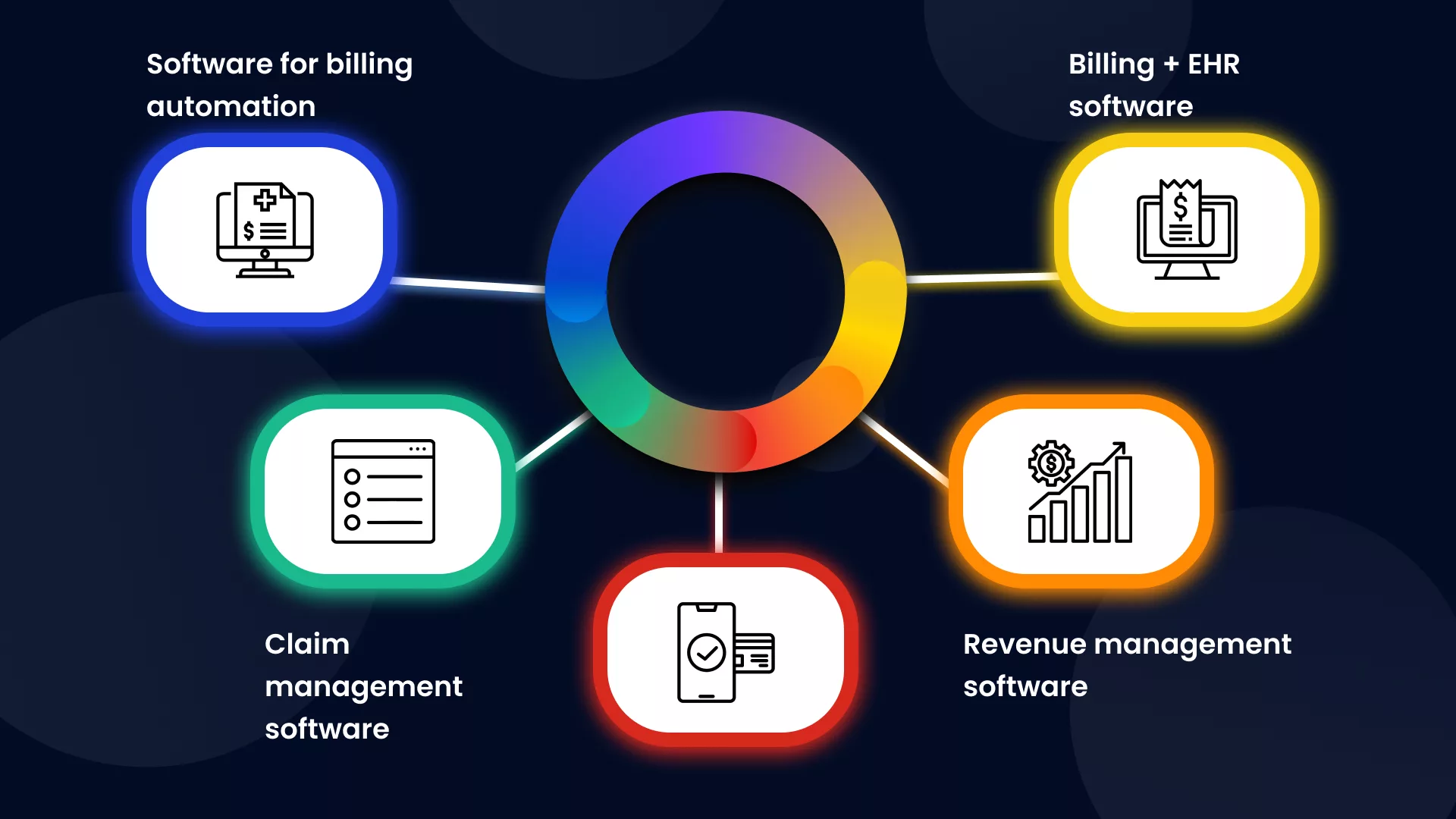
This software not only makes billing and coding for health insurance quicker and more precise but also comes with tools for managing money and analyzing how profitable a healthcare facility is. It also ensures that healthcare providers follow important rules, like the Health Insurance Portability and Accountability Act (HIPAA).
And the benefits don’t stop there! Studies show that medical billing software can:
- Increase patient bill payments by a whopping 154%!
- Boost revenue by 24%, making your practice healthier.
- Speed up claim turnaround time by 75%, reducing frustration.
The global medical billing software market is booming, growing at a steady 12.3% per year. That’s no surprise, considering the value it brings.
FEATURES OF MEDICAL BILLING AND CODING SOFTWARE
The intricacies of medical billing and coding, historically burdened by manual processes, have long been susceptible to errors, claim denials, and revenue leakage. Dedicated software, however, revolutionizes this landscape by introducing robust functionality that streamlines data management and empowers healthcare facilities across numerous key areas.
1. Comprehensive patient management:
- Streamlined registration. Efficient patient intake with demographic capture, insurance verification, and eligibility checks.
- Appointment scheduling. Intuitive scheduling tools minimize conflicts and optimize resource allocation.
- Follow-up automation. Automated reminders and communication tools enhance patient engagement and adherence.
- Patient portal integration. Secure online access for patients to manage appointments, view statements, and make payments.
2. Optimized claims management:
- Automated claim submission. Streamlined electronic claims submission for faster reimbursements.
- Real-time coding assistance. AI-powered suggestions and compliance checks minimize coding errors and denials.
- Proactive denial management. Early identification and resolution of denied claims to maximize revenue recovery.
- Advanced reporting and analytics. Data-driven insights into claim performance and potential areas for improvement.
3. Seamless billing and revenue cycle management:
- Automated invoicing. Efficient generation and delivery of accurate patient statements.
- Integrated payment processing. Secure online and offline payment options for improved convenience and collection rates.
- Automated follow-up for unpaid balances. Efficient collection processes to minimize outstanding accounts receivable.
- Comprehensive reporting and analysis. Real-time financial insights and performance metrics to optimize revenue cycle efficiency.
4. Enhanced workflow management and collaboration:
- Integrated scheduling and billing. Eliminate data silos and redundancies for a seamless patient experience.
- Centralized communication hub. Secure messaging and collaboration tools for improved internal communication.
- Role-based access control. Several access levels ensure data security and user accountability.
- Automated reporting and workflow analysis. Identify bottlenecks and optimize processes for increased productivity.
5. Data-driven business intelligence:
- Real-time reporting. Comprehensive dashboards and reports across KPIs.
- Financial analytics. Track revenue trends, identify cost drivers, and make informed financial decisions.
- Benchmarking. Compare performance against industry standards and identify areas for improvement.
- Predictive analytics. Leverage data to forecast future revenue and resource needs.
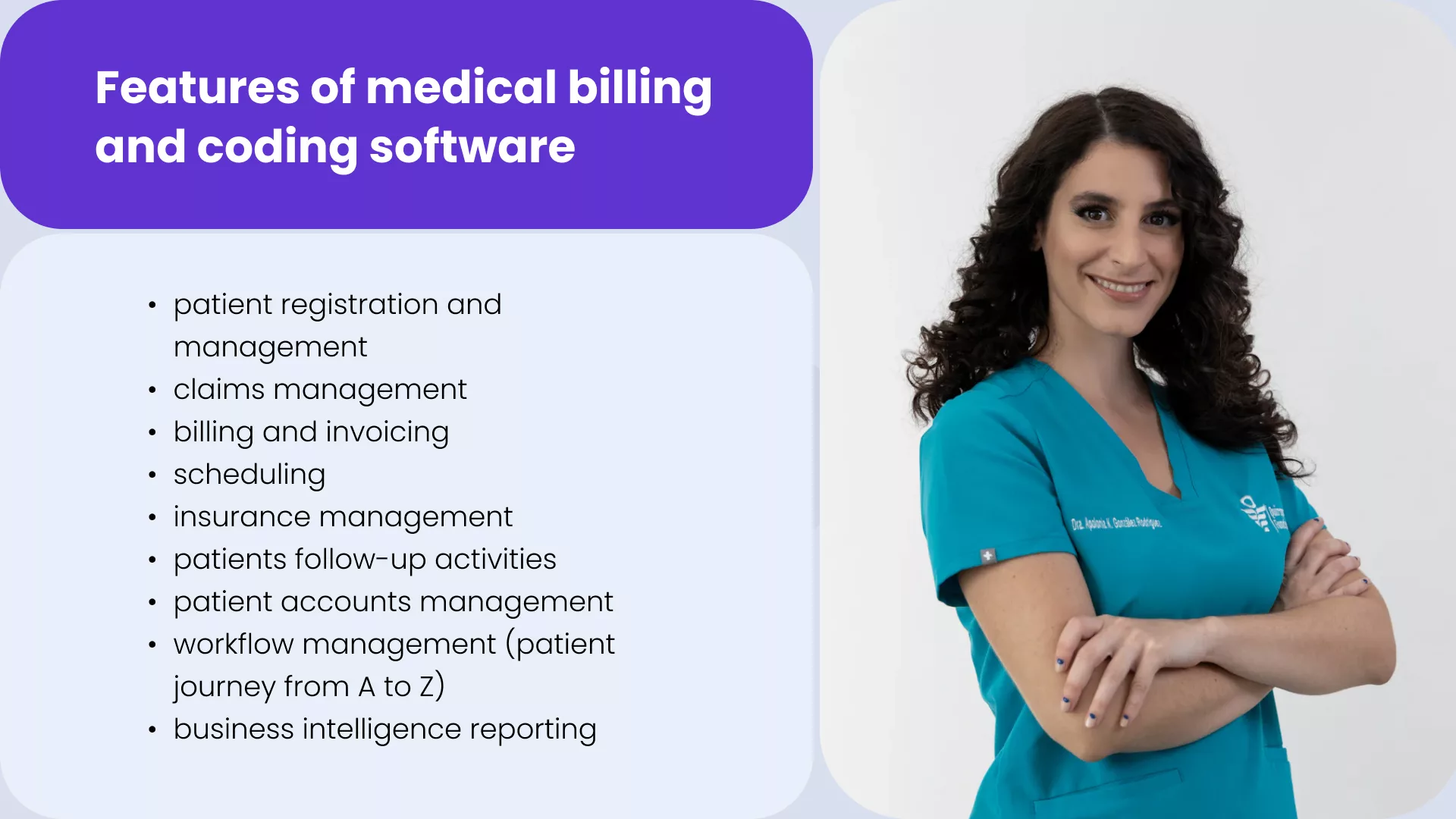
Challenges to overcome with medical billing and coding software
Financial sustainability is a critical concern for healthcare providers, particularly small and medium-sized practices. Studies reveal that low payments plague 83% of these practices, while ineffective communication regarding patient payment accountability further complicates revenue collection. Medical billing and coding software emerge as a powerful tool to address these challenges and optimize the revenue cycle.
Data accuracy
Manual data entry remains a significant source of errors, leading to claim denials and lost revenue. These errors can be as simple as a misspelled name or an incorrect date of birth, yet they cost the healthcare industry an estimated 20% of physician income annually. Modern software automates patient information entry, leveraging verified data sources to reduce errors and streamline the billing process. Additionally, integrated claim scrubbing tools identify missing information or inconsistencies before submission, minimizing the risk of denials.
Precise coding and compliance
Incorrect medical coding is another prevalent issue, often due to outdated codebooks, coding errors, or lack of familiarity with specific insurance requirements. This can lead to delayed reimbursements and lost revenue. Advanced software utilizes automated coding functionalities, ensuring adherence to the latest coding standards and specific payer guidelines. It suggests relevant and updated codes based on diagnosis and procedure information, eliminating the risk of human error and ensuring accurate claim submission.
Regulatory complexity
Healthcare regulations and compliance requirements evolve continuously, posing a significant challenge for providers to stay informed and adapt their practices accordingly. Dedicated software simplifies this process by incorporating comprehensive compliance features. Intuitive dashboards provide real-time insights into patient payment compliance, while automated reporting ensures adherence to federal regulations and industry best practices. This proactive approach minimizes the risk of non-compliance penalties and fosters a culture of transparency and accountability.
The dedicated software has medical compliance functionality and can help one comply with some or all of these medical compliance standards. They introduce an intuitive dashboard that ensures monitoring of each client’s payment compliance and provides instant access to real-time data and reports that contain information on their compliance with federal regulations and best practices.
Best medical billing and coding software
The best medical billing software revolves around the needs of a particular institution — that’s why off-the-shelf solutions are often less popular than custom solutions built around specific business needs. However, there are some reliable software we should mention.
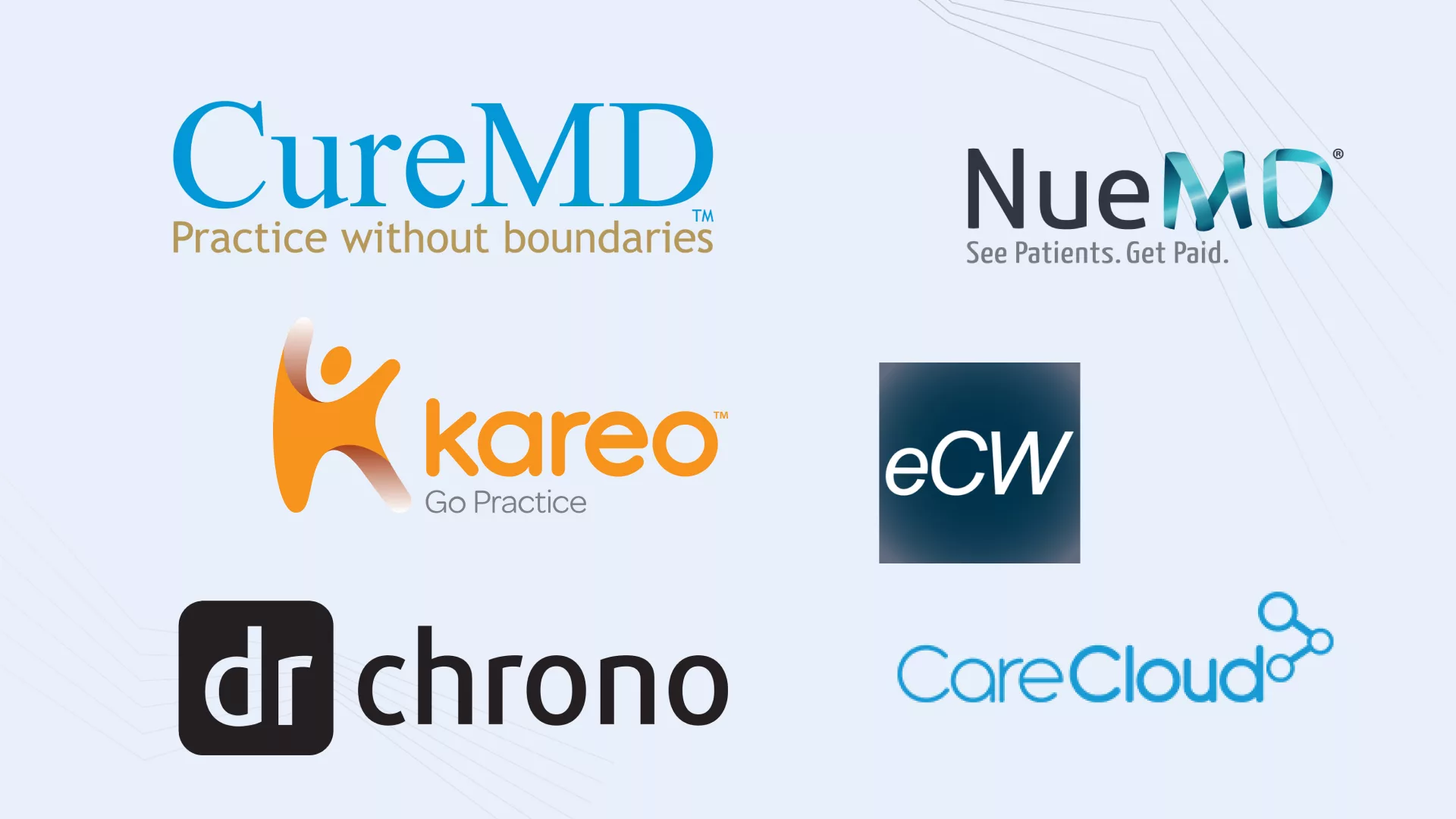
The proper solution automates and streamlines scheduled appointments, cuts down paperwork, creates smooth digital workflows for critical processes, and automatically enters patient information during doctor visits. A good example is Kareo Billing — the solution for efficient scheduling, claims management, billing, payment, revenue management, etc. Another is Cure MD which provides easy updates of a patient’s data and fosters automation of repetitive, time-consuming tasks.
One of the most acknowledged solutions is also DrChrono which includes configurable medical forms, e-prescribing, scheduling, and more with no need to download additional modules.
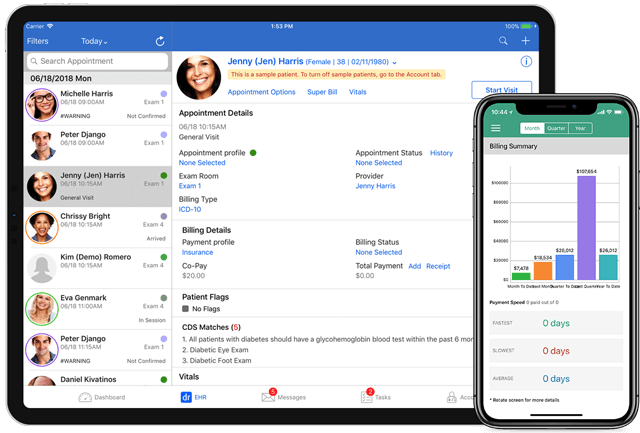
Example of claims eligibility status and appointment details in DrChrono
Among other popular solutions for medical billing and coding are eClinicalWorks, NueMD, and CareCloud.
- eClinicalWorks is a comprehensive EHR system with integrated billing and practice management capabilities. Strong in clinical functionality and population health management, but billing features may not be as advanced as dedicated solutions. Best suited for practices seeking a comprehensive EHR with integrated billing.
- NueMD is a cloud-based EHR with billing and practice management tools designed for ambulatory care practices. It offers flexible pricing and a user-friendly interface but may lack some advanced functionalities compared to larger competitors.
- CareCloud is a cloud-based platform offering EHR, billing, and practice management solutions for various healthcare specialties. Strong in revenue cycle management and analytics, but may require some customization for specific needs. Pricing can be complex depending on the chosen modules.
The usage of these solutions can improve one’s credibility across insurance companies. Above all, however, the best software provides a bird’s eye view of your medical facility with detailed reports and analytics.
How much does it cost to create MEDICAL BILLING AND CODING SOFTWARE?
Developing medical billing and coding software is a complex undertaking, and the cost can vary significantly depending on several factors.
1. Scope and features.
Simpler software with core functionalities like claims management and patient billing will cost less than platforms offering advanced features like EHR integration, AI-powered coding assistance, and real-time analytics. Highly customized solutions tailored to specific needs will inevitably be more expensive than off-the-shelf versions.
2. Development model.
Building the software internally requires hiring and managing a development team, including programmers, testers, and UI/UX designers. This can be the most expensive option but offers full control and customization.
Partnering with a software development company can be more cost-effective but requires careful selection and clear communication to ensure your vision is realized.
Utilizing existing open-source platforms can be the most affordable option but may require additional development work to meet specific needs and may have limitations in functionality and customization.
3. Technology stack.
The chosen technologies for building the platform, such as programming languages, databases, and cloud infrastructure, can impact the development cost. At the same time, ensuring adherence to healthcare data security regulations like HIPAA necessitates additional measures and tools, increasing development costs.
4. Ongoing maintenance and updates
Maintaining the software with bug fixes, security patches, and new features requires ongoing development efforts and costs. Meanwhile, adapting to evolving healthcare regulations and coding standards requires continuous updates, adding to the long-term cost. It’s hard to provide a specific cost estimate without details; however, there is a general range to consider:
Basic custom software will cost you $30,000 – $100,000+
Advanced custom software will be more expensive and will take $100,000 – $500,000+
But there is a way to cut your costs – by choosing third-party development partnerships!
Why should you outsource the medical billing and coding software development?
The software can be integrated into your existing system or developed from scratch – both options are valid. However, organizations often opt to involve third-party specialists as eventually, it requires fewer sacrifices.
For example, when choosing an outsourcing company, you can delegate as much of your managing functions as you wish. You can also vary the level of your engagement with the technical issues of the project. The size of the worldwide medical billing outsourcing market was estimated at USD 11.1 billion in 2021, and from 2022 to 2030, it is anticipated to increase at a CAGR of 12.0%.
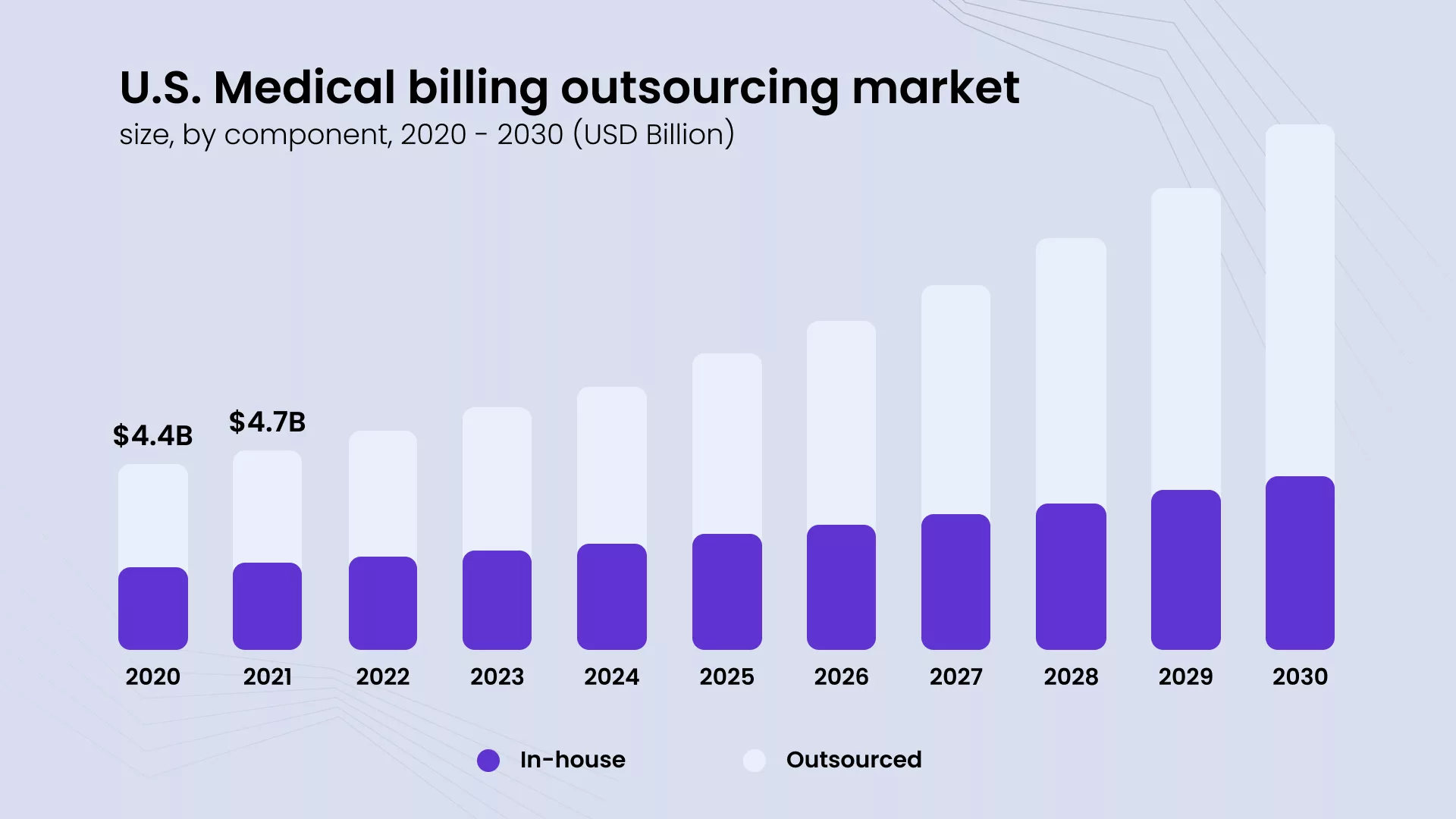
Medical billing outsourcing market | Grand View Research
In addition, medical billing software that is not tailor-made for one’s practice creates bottlenecks in the billing workflow. Thus, providers should have second thoughts anytime they come across software that claims to be an all-in-one solution or works for all specialties.
When there are seasoned professionals in the market who are aware of all the intricacies of healthcare product development, sometimes it’s wise to outsource the job. And this is what many organizations eventually do.
MEDICAL BILLING AND CODING SOFTWARE DEVELOPMENT
Having completed numerous healthcare projects, it’s clear to us that developing software in this field is a challenging endeavor that demands careful planning. Medical billing and coding software must offer a broad range of features, including data analysis and storage capabilities, intuitive user interfaces, and adherence to the strict regulatory standards of the healthcare industry.
Key features of medical billing and coding software
While billing, claim management, accurate coding, data security, and reporting remain fundamental pillars of medical billing and coding software, the landscape has evolved beyond these basic functionalities.
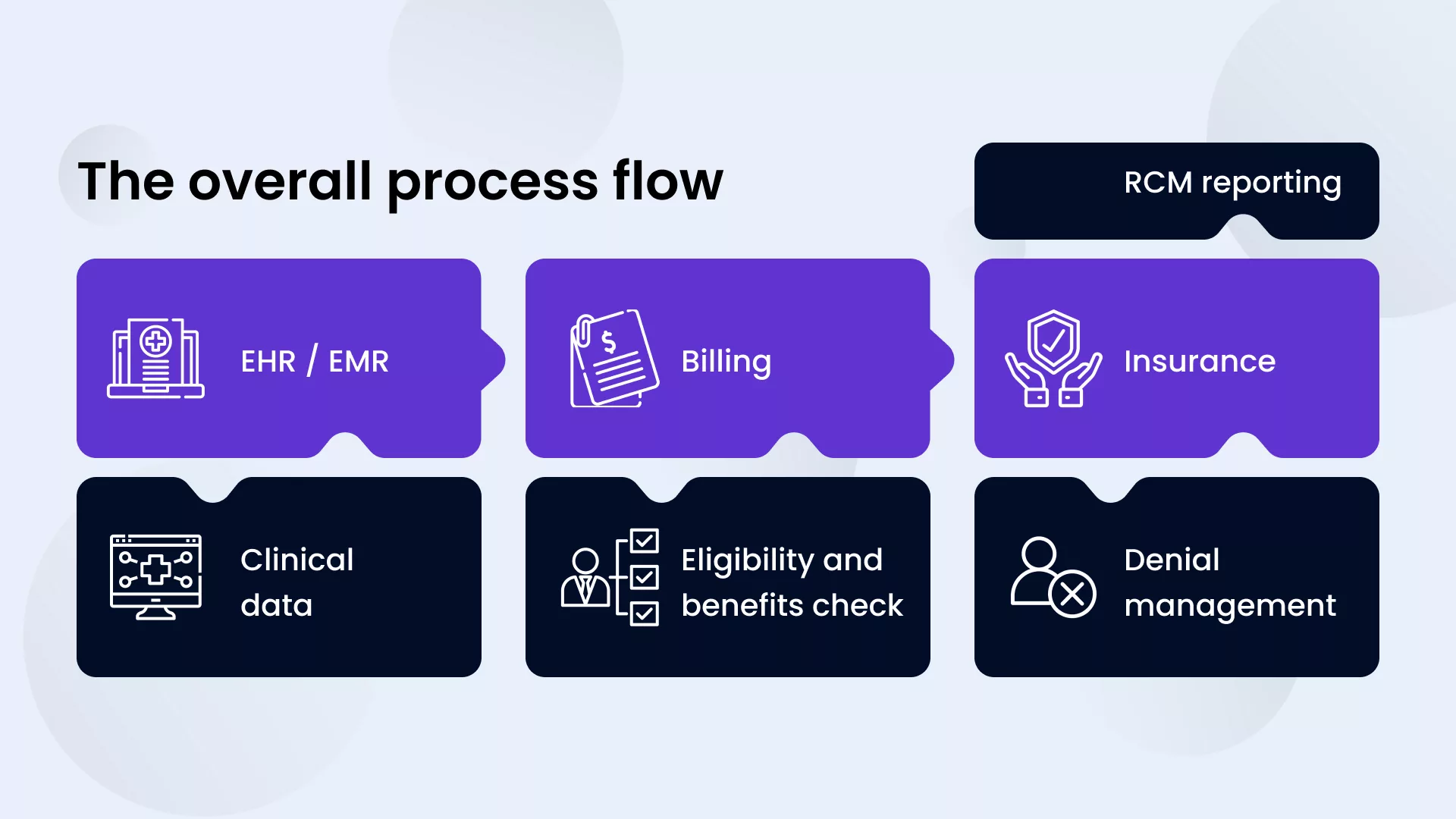
Here are the technologies you should consider when creating or choosing medical billing and coding software in 2024.
- Automation and AI-powered assistance: Automated data entry can eliminate manual errors and streamline workflows with features like patient portal pre-registration and insurance verification automation. AI-powered coding assistance can reduce coding errors and ensure compliance with real-time suggestions and automated code selection based on diagnoses and procedures. Automated claim scrubbing and submission will identify and fix potential claim errors before submission, minimizing denials and maximizing reimbursements.
- Enhanced patient engagement: Secure patient portals will empower patients to manage appointments, view statements, make payments, and communicate securely with providers. Automated appointment reminders and follow-ups will reduce no-shows and improve patient adherence with automated communication tools. Personalized patient billing will generate statements with clear explanations and offer flexible payment options to improve understanding and collection rates.
- Integration and interoperability: EHR integration will stimulate seamless exchange of data with EHRs for improved patient care and streamlined billing processes. Telehealth billing integration will help with the efficient billing of virtual consultations. Cloud-based platforms will ensure secure and centralized access to data from any device, fostering collaboration and remote work flexibility.
Medical billing
Once there is a need to bill for medical services, the EHR/EMR system sends all the services provided to medical billing software. One of the main functions of your software is invoicing customers. The software is used to process and track payments, keep track of invoices and payment transactions, and manage all associated billing data for appointments and treatments received. The billing software also automatically notifies patients when their insurance is about to expire or about unpaid payments. Automation of this process saves a lot of time for medical facilities. Healthcare providers or businesses spend 30 to 40% of their revenue on the billing process.
Medical coding
We have already mentioned that the correct medical coding system is a key point in receiving payment. Medical billing, however, is prone to mistakes and can be challenging even for the most seasoned certified outpatient coder. That is why a digital solution should include a function to search for codes using numbers, keywords, acronyms, or abbreviations. Each code should include a detailed description to ensure you select the correct code before including it in to claim.
Claims management
With this feature, the software can automatically send, receive, and manage claims (including resubmissions). The latter provides a review of all changes and manages rejections and errors in real-time. This feature also ensures a higher acceptance rate, scrubbing your claims for HIPPA, LCD, and CCI.
Insurance verification
Usually, specific individuals or an entire department check whether patients have the necessary insurance coverage. Medical billing software should also perform insurance verification automatically. For this, it must integrate with the networks of insurance operators. This will speed up the admission of patients and reduce the percentage of refusals.
Secure data storage
Data security is a backbone when it comes to the healthcare industry. Medical billing software stores sensitive data such as personal patient and insurance information, billing and banking information, medical records, medications, transaction history, and more. Data storage of this information must be secure and comply with HIPAA or GDPR standards. Therefore, before developing software, it is important to make sure the software provider knows the ins and outs of healthcare information security.
Reporting
One of the most crucial features of proper software is also an analysis of operations and identification of aspects that need improvement. Make sure your solutions generate real-time data and include convenient interactive tools that will allow you to capture information and finalize in a form of reports that will reflect the practice’s financial trends, areas, and opportunities for revenue growth.
How to create medical billing and coding software: A step-by-step guide

The following guide unfolds major steps to creating a system that empowers providers, satisfies regulations, and streamlines the whole financial flow.
Step 1: Assemble a team of experts
The foundational phase in the development of medical billing and coding software involves the selection of experienced software development professionals to create customer support, continuous maintenance, tailored billing solutions, and comprehensive reporting, with direct assistance available throughout the implementation phase.
The complexity of such a project transcends the capabilities of a single individual. Even to create an MVP, you will need a collaborative effort from a team of developers.
The project would gather skilled individuals who would develop, design, and test your product. Apart from coders, developers, and architects, you will need:
- Quality assurance specialists
- UI/UX designers
- Graphic designers
- Project manager
- Business analysts and other requisite specialists
Given the unique characteristics of the healthcare sector, think of engaging an IT vendor with extensive experience in this domain. MWDN boasts a portfolio of successful healthcare projects, including the development of a noninvasive monitoring program for NIMedical. For further insights into our healthcare project expertise, contact us right away.
Step 2: Document architecture and requirements for your future software
After a successful selection of external or in-house developers, your next step is to analyze the budget and set up the requirements for the future product.
Along the way, it is necessary to determine immediately what the cost of development is, whether the available resources are sufficient for this, and whether additional funding will be required.
Next, you should record the software’s needs and mandatory features. These should revolve around your business needs. For example, sometimes a system doesn’t need to be developed from scratch – integration of some innovative features will be enough to solve potential problems or provide additional value to your customers. Anyway, the task of your developers is to help you decide how to get the best result with optimal costs.
Step 3: Define the optimal tech stack
Selecting the right combination of technologies depends on your project, including the need for scalability, the complexity of billing processes, and integration with existing healthcare systems. You should also consider the long-term maintenance and support of the software, ensuring that the chosen tech stack is well-supported and has a strong community behind it. Below are several examples of technologies that could comprise an effective tech stack for our medical software.
Frontend
- React is known for its efficiency and flexibility, it allows for building dynamic and responsive user interfaces that can handle complex features and user interactions.
- Angular offers a comprehensive framework for developing scalable and robust web applications, with built-in features for form handling, validation, and routing, which are essential for medical billing software.
Backend
- Node.js is suitable for building fast and scalable server-side applications. Its non-blocking, event-driven architecture can handle numerous simultaneous connections with ease.
- .NET core is a cross-platform framework by Microsoft that is known for its reliability, security features, and ability to handle high-level complexities of medical billing software.
Database
- PostgreSQL is an open-source, object-relational database system that offers reliability, data integrity, and compliance with ACID properties, making it suitable for handling sensitive medical data.
- MongoDB is a NoSQL database that can handle large volumes of structured and unstructured data, providing flexibility and scalability for dynamic medical billing applications.
Cloud services
- AWS offers a broad set of global cloud-based products, including storage, databases, and analytics, which can support the infrastructure needs of medical billing software.
- Microsoft Azure provides a wide range of cloud services, including AI and machine learning capabilities, security, and compliance features, making it a good choice for healthcare applications.
Security and compliance
- OAuth 2.0 and OpenID Connect: For secure authentication and authorization.
- HIPAA compliance tools: Solutions like AWS’s HIPAA Eligible Services or Azure’s offerings can help ensure that the software meets healthcare compliance requirements.
DevOps tools
- Docker is for containerization, ensuring consistent environments across development, testing, and production.
- Jenkins or GitHub Actions – for CI/CD, automating the software development process.
The basic tech stack our team used for creating medical software consisted of MySQL for storage, Angular, React, and Vue for the front end, and Ruby on Rails for the back end.
Step 4: Ensure Integrations
In the beginning, we mentioned that integrations are a key stage in the functioning of your software. When it comes to medical billing software, it should include a wide range of integrations with other systems:
- EMR and EHR that store patient information
- Accounting software that processes payments
- Insurance providers to automate the process of verifying your patients’ eligibility for insurance
Try out HL7 FHIR (Fast Healthcare Interoperability Resources) for integrating with EHRs and other healthcare systems, and EDI (Electronic Data Interchange) standards, which is essential for processing healthcare claims and ensuring compatibility with insurers and other healthcare providers.
Mind that it’s easier to add third-party tools or required functionality to extend an existing one than to build an entire system from scratch. The latter contains patients’ medical information and helps healthcare providers to organize and prioritize practice workflows.
Step 5: UI and UX Design
Technology and medical software are ever integrated into the modern healthcare industry. Such solutions often analyze complex parameters and scientific metrics, so there is an urgent need for the data to be translated to the user in an appropriate, easy-to-understand format. As medical coding technologies are a daily part of a workflow, they should have simple navigation and intuitive menus. The user experience is also influenced by the color scheme and text readability. In addition, each billing and medical coding system should be tailored to the needs of the target audience that works with it (doctors, nurses, patients, etc.).
Prioritizing user experience in medical billing and coding software is essential for improving workflow, user satisfaction, and, ultimately, the software’s overall success. Statistics show that investing in UX can yield tremendous returns. Every $1 invested can result in a $100 return (a 9,900% ROI).
When developing healthcare software, an impressive design is often one of the most requested parameters the MWDN team gets. A real-world example is a design for NICaS – a non-invasive assessment and monitoring system for hemodynamics and fluids management that works perfectly, introducing an impressive yet clear design for medical personnel.
Step 6: Deployment and maintenance
Medical software has some peculiarities of deployment and maintenance. These are issues you should always consider when running billing and coding software:
- Compliance. Adhering to strict HIPAA and industry regulations requires careful configuration and testing.
- Data security. Sensitive patient information demands robust security measures during deployment and ongoing maintenance.
- Integration complexity. Integrating with EHR systems, insurance platforms, and other software requires compatibility and data mapping expertise.
- Workflow disruption. Minimizing disruption to ongoing billing and coding processes during deployment is crucial.
- Regulatory updates. Frequent changes in regulations necessitate regular updates and adjustments to the software.
- Security patching. Continuous security patching is essential to address vulnerabilities and prevent data breaches.
- Performance optimization. Regular performance monitoring and optimization ensure smooth operation and data integrity.
- User training. New features and updates might require ongoing user training to maintain efficiency.
- Scalability. The software should adapt to growing data volumes and user needs.
- Disaster recovery. A robust disaster recovery plan ensures data protection and system availability in case of emergencies.
MEDICAL BILLING AND CODING SOFTWARE DEVELOPMENT WITH MWDN
Medical billing and coding software isn’t just about searching and sorting codes. It’s a powerful tool that can boost accuracy, compliance, and revenue for your healthcare organization. However, building such software requires experienced professionals who understand the industry and have a proven track record.
That’s where MWDN comes in. With 20 years of experience, we offer staffing and hiring solutions for healthcare companies. Here’s what you get with us:
- Simplified workflows. We take the burden of hiring, onboarding, and managing your remote dedicated engineers, so you can focus on what matters, not paperwork.
- Deep industry expertise. Our team understands the challenges and complexities of healthcare billing and coding.
- Tailored solutions. We hire software engineers that seamlessly integrate with your existing teams and processes.
We have a global network of skilled developers located in Israel, Eastern Europe, Canada, and other top destinations. We match them to your project based on your needs, technology, and culture to ensure a perfect fit.
Ready to turn your vision into reality? Contact us today, and let’s create a modern solution that simplifies your administrative burden and helps you thrive.
Content
- 1 What software do you need for medical billing and coding?
- 2 Challenges to overcome with medical billing and coding software
- 3 Best medical billing and coding software
- 4 How much does it cost to create MEDICAL BILLING AND CODING SOFTWARE?
- 5 Why should you outsource the medical billing and coding software development?
- 6 MEDICAL BILLING AND CODING SOFTWARE DEVELOPMENT
- 7 How to create medical billing and coding software: A step-by-step guide
- 8 MEDICAL BILLING AND CODING SOFTWARE DEVELOPMENT WITH MWDN


